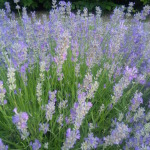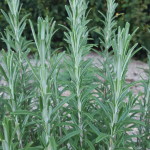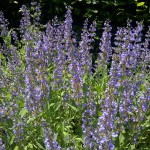Four Thieves Vinegar was used in the Middle Ages to protect people from the plague. Legends claim that it was used by thieves who were robbing the dead and dying, to prevent themselves from being infected. There is some scientific evidence that the concoction has anti-bacterial properties. Now, of course, we have antibiotics to protect us from disease.
Four Thieves Vinegar is still made today and used in vinaigrette. The traditional recipes call for up to a dozen ingredients. The modern recipes hew to the legend of the four thieves and use four herbs (one for each thief) lavender, rosemary, sage and thyme plus garlic.
Lavender (Lavandula spp) is a member of the mint family and native to southern Europe. It is a shrubby perennial that comes in seemingly infinite varieties. When purchasing lavender, look at the Latin name. There are three types of lavender commonly offered for sale: Lavandula angustifolia (known as English lavender), L. stoechas (known as Spanish lavender, the flowers look like butterflies), and L. dentata (known as French lavender, the leaves are serrated). For your four thieves vinegar, you want to grow English lavender.
English lavender is hardy in zones 5-8. Which variety you choose depends entirely on the amount of space you have. If you have only a small amount of space or are growing your herbs in containers, choose either “Hidcote” which grows to 24 inches or “Munstead” which grows to 18 inches. If you are blessed with a large garden, I highly recommend “Provence” which is used in the perfume industry and grows to 30 inches. Another good choice is “Grosso” which also grows to 30 inches. Gardeners love “Phenomenal” lavender which is indeed phenomenal, showing great cold and disease resistance and profuse blooms. All three will become small shrubs so make sure you give them enough space.
Lavender is easy to grow and seemingly indestructible. In some parts of Europe, it’s considered an invasive weed! Don’t waste your money buying seed. The germination rate is miniscule except for an AAS variety called Lady Lavender which is very tiny and not terribly fragrant. Buy a plant and put it in the sunniest, hottest, driest spot in your garden and then forget about it. Nothing will grow along your driveway or in the hell strip between the sidewalk and the street? Lavender will love it there.
You will be using the lavender flowers for your vinegar. Harvest the flowers and the stems (wands) when the buds are just beginning to open. Tie the wands together and hang them in a dark, dry place that is well ventilated until the flowers are completely dry. Remove the stems.
Rosemary (Rosmarinus officinalis) is native to the Mediterranean area. It is a woody perennial that is reliably hardy through zone 7. It can survive mild winters with protection in zone 6. In northern areas, rosemary should be grown in pots and brought inside once the outdoor temperatures are less than 30°F. Mature plants grown outside can reach a height of 5 feet. Rosemary is a member of the mint family but is not invasive. It is often used as an ornamental shrub because it can be pruned into hedges and topiary.
Rosemary is usually propagated by cuttings. Start your cuttings 6 weeks before your last frost date. After the last frost date, rosemary should be planted in a sunny garden and not overwatered. It can be treated similar to your lavender. Because rosemary requires a lot of sun. When brought indoors, supplemental lighting is recommended. Leaves can be harvested year round.
Sage (Salvia officinalis) is another non-invasive member of the mint family. It is native to the Mediterranean but has naturalized throughout much of the world. It is a perennial sub-shrub that is hardy through zone 5. The plants become woody within three to four years and will need to be replaced. Mature plants reach a height of 3 feet.
Sage can be grown from seeds or cuttings. Seeds can be started indoors 1 to 2 weeks before your last frost date. Cuttings take longer and should be started 6 to 8 weeks before your last frost date. Plant your sage in a sunny, well-drained location. Sage does not like wet feet. Wait until the second year before harvesting the leaves.
Thyme (Thymus vulgaris), a non-invasive member of the mint family, is native to the Mediterranean area. It is a small, shrubby perennial that is hardy through zone 5. Mature plants range in size from 6 to 12 inches, depending on the variety.
Thyme is difficult to grow from seed. It is usually propagated by division or cuttings. Thyme prefers a sunny location, but it can tolerate a little shade. What it can’t tolerate is over watering. Thymes are drought tolerant plants like lavender and rosemary and should be treated the same. You can harvest your thyme any time after it becomes established in your garden.
To make your Four Thieves Vinegar, combine equal parts lavender flowers, rosemary, sage and thyme leaves , 2 to 4 cloves of garlic and a quart of vinegar in a tightly sealed container. Place the container in a dark place such as a cupboard and leave it there for four to six weeks, shaking every few days. To use, strain the herbs and garlic out of the vinegar using a cheesecloth and transfer the vinegar into a clean container. The vinegar can be used for up to 18 months if stored in a cool, dry place.






4 Comments on “Grow Your Own Four Thieves Vinegar”
Pingback: Four Thieves Vinegar - pour a little history on your salad | Advice From The Herb LadyAdvice From The Herb Lady
Hello again Diane, you are such a sweet heart. I did much the same as you this fall, except I had a big pot of mixed herbs ( thyme, orengao, sage, cilantro, rosemary, soup celery) that I had planted up in the spring and then I just brought the whole thing inside for the winter. They did very well and now they are getting all sorts of fresh spring growth. So I have just taken a bunch of? clippings of most of them, potted them up and have them on the heat mat. I think that should work.
I can not grow lavender, so what can i use to replace it in my thieves vinegar?
I am not an herbalist so I can’t help you with that. I can help with growing lavender. Why do you say that you can’t grow it?